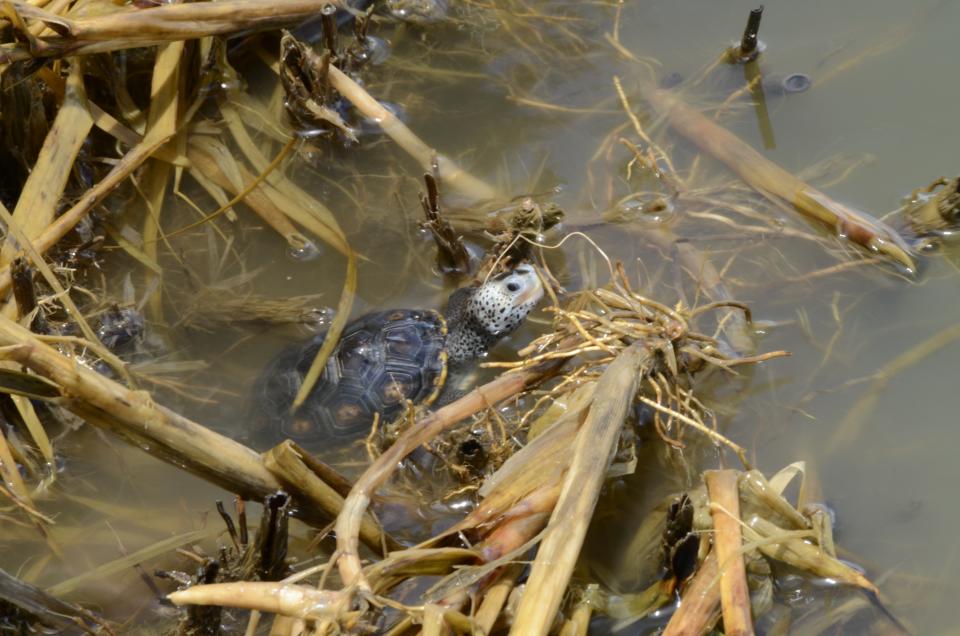The Louisiana Department of Wildlife and Fisheries (LDWF) along with the National Oceanic and Atmospheric Administration (NOAA) and Louisiana’s Coastal Protection and Restoration Authority (CPRA) joined citizen volunteers in releasing 21 diamondback terrapin hatchlings back into the wild Thursday (July 6).
The hatchlings, whose eggs were discovered by scientists at a Deepwater Horizon restoration site last year, were released on Chenier Ronquille, a coastal barrier island northeast of Grand Isle. The island’s restoration was funded by Early Natural Resource Damage Assessment (NRDA) dollars (Phase III) that went to NOAA for their Outer Coast Restoration Project to restore beach, dune and back-barrier marsh habitats, as well as brown pelicans, terns, skimmers and gulls to help compensate the public for spill-related injuries and losses to these resources.
“Partnerships and cooperation between public agencies are crucial to successfully managing wildlife,’’ LDWF Secretary Jack Montoucet said. “Having private citizens assist us is a prime example of how that cooperation can be extremely effective. Diamondback terrapins are one of our species of greatest conservation need. So having a chance to return some to their natural environment aids in making sure the population remains stable.’’
“CPRA’s coastal work oftentimes goes beyond the obvious building, preserving and restoring land and habitat,” said CPRA Chairman Johnny Bradberry. “In many cases, our attention is called to the preservation of species that once called a location home, along the coast. It’s good to see that these terrapins are now back where they belong.”
The story began in July of 2016 when Keri Landry, an endangered species biologist with LDWF’s Louisiana Natural Heritage Program, was contacted by NOAA about diamondback terrapin eggs found on the Chenier Ronquille Barrier Island Restoration Project.
Chenier Ronquille is a barrier island located at the entrance to the Barataria Basin in Louisiana that is being restored through Deepwater Horizon early restoration efforts. The restoration is a component of the Louisiana Outer Coast Restoration Project, which restores beach, dune and back-barrier marsh at four barrier island locations. Other project components are being implemented by the CPRA and the U.S. Department of the Interior.
“Louisiana’s barrier islands and headlands are the first line of defense during storms, reducing the effects of wind, waves and flooding on coastal marshes,” said Pat Montanio, Director of NOAA Fisheries’ Office of Habitat Conservation. “They also provide habitat for fish, shrimp, birds and other wildlife, but have been impacted by storms and oil spills like Deepwater Horizon. We’re happy to support this important effort, restoring habitat that helps protect coastal communities in Louisiana.”
Landry traveled to the barrier island to collect the diamondback terrapin eggs. Unable to incubate the eggs or raise the hatchlings, she contacted David and Karen Milliken, who assist LDWF with its work with gopher tortoises, a federal and state-protected species. The Millikens incubated the eggs during July 2016.
The eggs were then turned to Steven and Rachael Creech in August 2016. They hatched in August 2016. The Creechs raised them since that time. Under their constant care, the terrapins have nearly tripled in size since hatching and are now ready to be released into Louisiana’s coastal barrier island system.
“LDWF didn’t have the ability to incubate and raise the terrapin eggs,’’ Landry said. “The Millikens and the Creechs have worked with LDWF in the past and came alongside again to help out. They were instrumental in caring for these hatchlings with their willingness to assist LDWF. LDWF’s partnerships with other agencies, like NOAA and CPRA, and with the Millikens and Creechs, make conservation of our most imperiled species a reality.”
To see photos and video from the release, click here.

